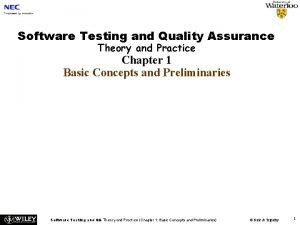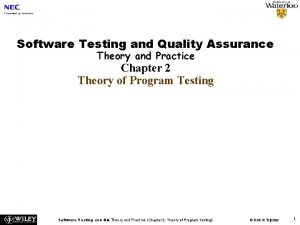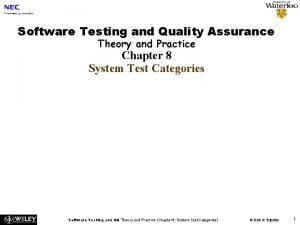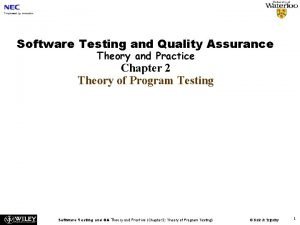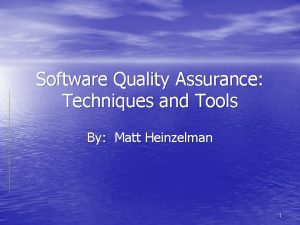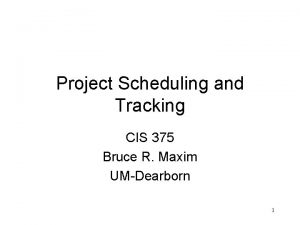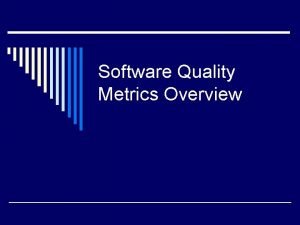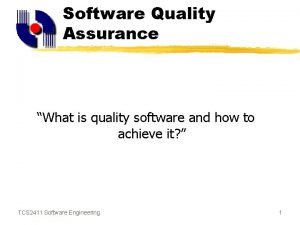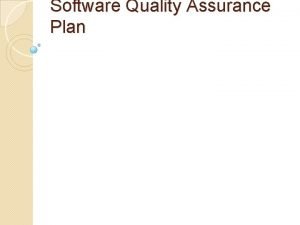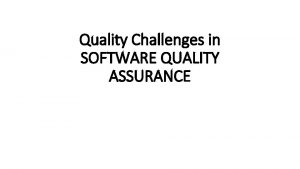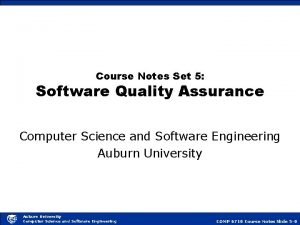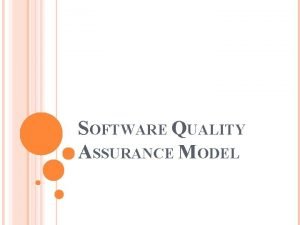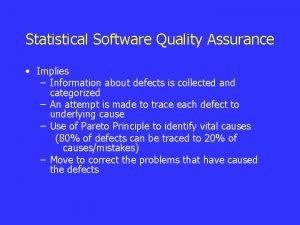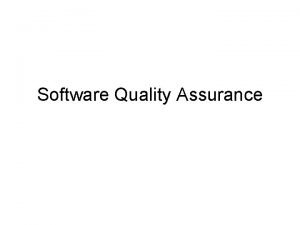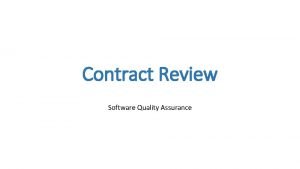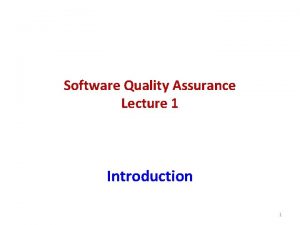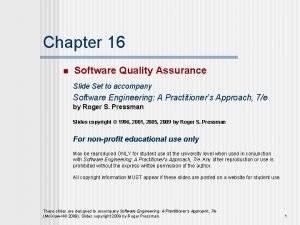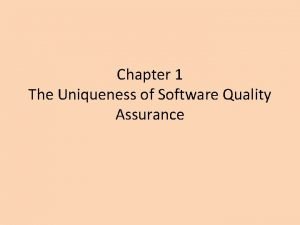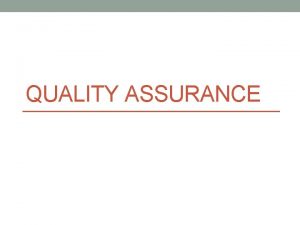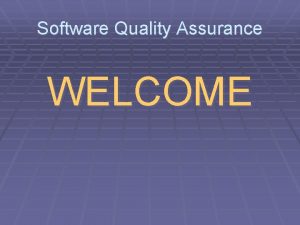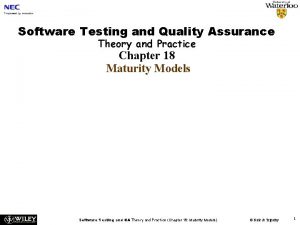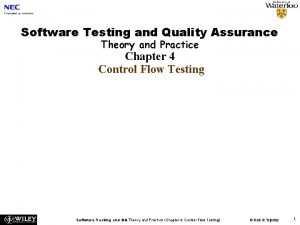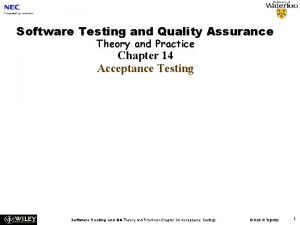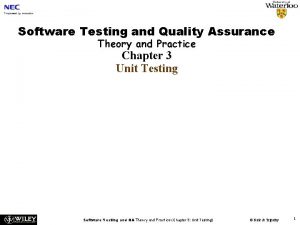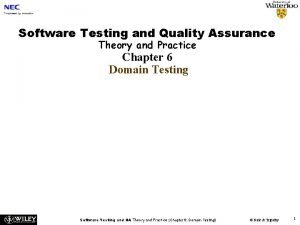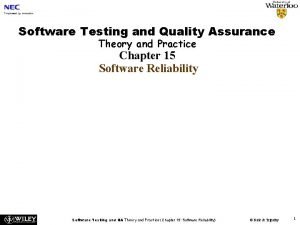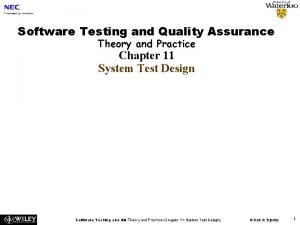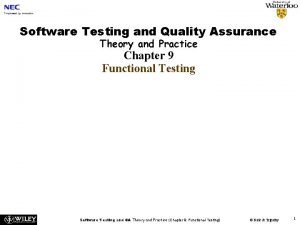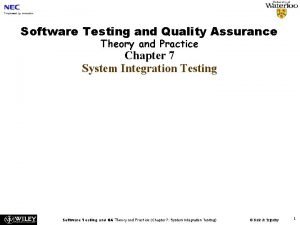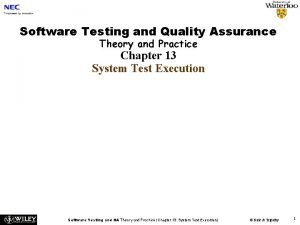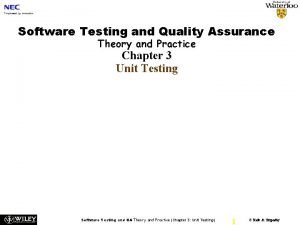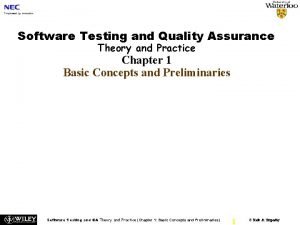Software Testing and Quality Assurance Theory and Practice































- Slides: 31

Software Testing and Quality Assurance Theory and Practice Chapter 4 Control Flow Testing Software Testing and QA Theory and Practice (Chapter 4: Control Flow Testing) © Naik & Tripathy 1

Outline of the Chapter • • Basic Idea Outline of Control Flow Testing Control Flow Graph Paths in a Control Flow Graph Path Selection Criteria Generating Test Input Containing Infeasible Paths Summary Software Testing and QA Theory and Practice (Chapter 4: Control Flow Testing) © Naik & Tripathy 2

Control flow refers to flow of control from one instruction to another Software Testing and QA Theory and Practice (Chapter 4: Control Flow Testing) © Naik & Tripathy 3

Outline of Control Flow Testing Figure 4. 1: The process of generating test input data for control flow testing. Software Testing and QA Theory and Practice (Chapter 4: Control Flow Testing) © Naik & Tripathy 4

• Control flow testing (white box testing) 1. Draw a control flow graph (CFG) from a program unit 2. Select a few control flow testing criteria 3. Identify a path in the CFG to satisfy the selection criteria 4. Derive the (test i/p) from the selection paths 5. By solving the (test i/p)for a path, one can generate the test i/p data See the Example in the Blackboard for Control Flow Testing Software Testing and QA Theory and Practice (Chapter 4: Control Flow Testing) © Naik & Tripathy 5

Basic Idea • Two kinds of basic program statements: – Assignment statements (Ex. x = 2*y; ) – Conditional statements (Ex. if(), for(), while(), …) • Program path – – – • A program path is a sequence of statements from entry to exit. There can be a large number of paths in a program. There is an (input, expected output) pair for each path. Executing a path requires invoking the program unit with the right test input. Paths are chosen by using the concepts of path selection criteria. Tools: Automatically generate test inputs from program paths. Software Testing and QA Theory and Practice (Chapter 4: Control Flow Testing) © Naik & Tripathy 6

Outline of Control Flow Testing • Inputs to the test generation process – Source code – Path selection criteria: statement, branch, … • Generation of control flow graph (CFG) – A CFG is a graphical representation of a program unit. – Compilers are modified to produce CFGs. (You can draw one by hand. ) • Selection of paths – Enough entry/exit paths are selected to satisfy path selection criteria. • Generation of test input data – Two kinds of paths • Feasible path/ Executable path: There exists input so that the path is executed. • Infeasible path: There is no input to execute the path. – Solve the path conditions to produce test input for each path. Software Testing and QA Theory and Practice (Chapter 4: Control Flow Testing) © Naik & Tripathy 7

Control Flow Graph • Example code: Return. Average() public static double Return. Average (int value[], int AS, int MIN, int MAX) { /* Function: Return. Average Computes the average of all those numbers in the input array in the positive range [MIN, MAX]. The maximum size of the array is AS. But, the array size could be smaller than AS in which case the end of input is represented by -999. */ int i, tv, sum; double av; i = 0; tv = 0; sum = 0; while (ti < AS && value[i] != -999) { ti++; if (value[i] >= MIN && value[i] <= MAX) { tv++; sum = sum + value[i]; } i++; } if (tv > 0) av = (double)sum/tv; else av = (double) -999; return (av); } Figure 4. 6: A function to compute the average of selected integers in an array. Software Testing and QA Theory and Practice (Chapter 4: Control Flow Testing) © Naik & Tripathy 8

Control Flow Graph Figure 4. 7: A CFG representation of Return. Average(). Software Testing and QA Theory and Practice (Chapter 4: Control Flow Testing) © Naik & Tripathy 9

Paths in a Control Flow Graph • A few paths in Figure 4. 7. (Table 4. 1) – – Path 1: 1 -2 -3(F)-10(T)-12 -13 Path 2: 1 -2 -3(F)-10(F)-11 -13 Path 3: 1 -2 -3(T)-4(T)-5 -6(T)-7(T)-8 -9 -3(F)-10(T)-12 -13 Path 4: 1 -2 -3(T)-4(T)-5 -6 -7(T)-8 -9 -3(T)-4(T)-5 -6(T)-7(T)-8 -9 -3(F)-10(T)-1213 Software Testing and QA Theory and Practice (Chapter 4: Control Flow Testing) © Naik & Tripathy 10

Path Selection Criteria • • Program paths are selectively executed. Question: What paths do I select for testing? The concept of path selection criteria is used to answer the question. Advantages of selecting paths based on defined criteria: – Ensure that all program constructs are executed at least once. (The programmer needs to observe the outcome of executing each program construct) – Repeated selection of the same path is avoided. (Executing the same path several times is a waste of resources) – One can easily identify what features have been tested and what not. • Path selection criteria 1. 2. 3. 4. Select all paths. Select paths to achieve complete statement coverage. Select paths to achieve complete branch coverage. Select paths to achieve predicate coverage. Software Testing and QA Theory and Practice (Chapter 4: Control Flow Testing) © Naik & Tripathy 11

Path Selection Criteria 1. All-path coverage criterion: Select all the paths in the program unit. Advantage: - it is desirable since it can detect error. Disadvantages – It’s difficult to select all possible paths in program in practice. – Producing all the inputs that exercise all the program paths is difficult process. Software Testing and QA Theory and Practice (Chapter 4: Control Flow Testing) © Naik & Tripathy 12

Path Selection Criteria Software Testing and QA Theory and Practice (Chapter 4: Control Flow Testing) © Naik & Tripathy 13

Path Selection Criteria 2. Statement coverage criterion – Statement coverage means executing individual program statements and observing the output. – 100% statement coverage means all the statements have been executed at least once. • Cover all assignment statements. • Cover all conditional statements. – Less than 100% statement coverage is unacceptable. – Example of Paths selected based on statement coverage criterion and CFG SCPath 1 1 -2 -3(F)-10(F)-11 -13 SCPath 2 1 -2 -3(T)-4(T)-5 -6(T)-7(T)-8 -9 -3(F)-10(T)-12 -13 Table 4. 4: Paths for statement coverage of the CFG of Figure 4. 7. Software Testing and QA Theory and Practice (Chapter 4: Control Flow Testing) © Naik & Tripathy 14

Path Selection Criteria 3. Branch coverage criterion – A branch is an outgoing edge from a node in a CFG. • A condition node has two outgoing branches – corresponding to the True and False values of the condition. – Covering a branch means executing a path that contains the branch. – 100% branch coverage means selecting a set of paths such that each branch is included on some path. – Example of Paths selected based on Branch coverage criterion and CFG Software Testing and QA Theory and Practice (Chapter 4: Control Flow Testing) © Naik & Tripathy 15

Path Selection Criteria Figure 4. 8: The dotted arrows represent the branches not covered by the statement covering in Table 4. 4. Software Testing and QA Theory and Practice (Chapter 4: Control Flow Testing) © Naik & Tripathy 16

Path Selection Criteria Software Testing and QA Theory and Practice (Chapter 4: Control Flow Testing) © Naik & Tripathy 17

Path Selection Criteria 4. Predicate coverage criterion Software Testing and QA Theory and Practice (Chapter 4: Control Flow Testing) © Naik & Tripathy 18

Path Selection Criteria Software Testing and QA Theory and Practice (Chapter 4: Control Flow Testing) © Naik & Tripathy 19

Generating Test Input • Having identified a path, a key question is how to make the path execute, if possible. – Generate input data that satisfy all the conditions on the path. • Key concepts in generating test input data 1. 2. 3. 4. 5. 6. Input vector Predicate Path condition Predicate interpretation Path predicate expression Generating test input from path predicate expression Software Testing and QA Theory and Practice (Chapter 4: Control Flow Testing) © Naik & Tripathy 20

Generating Test Input • 1 -Input vector – An input vector is a collection of all data entities read by the routine whose values must be fixed prior to entering the routine. – Members of an input vector can be as follows. • Input arguments to the routine • Global variables and constants • Files • Contents of registers (in Assembly language programming) • Network connections • Timers – Example: An input vector for openfiles() consists of individual presence or absence of the files “files 1, ” “file 2, ” and “file 3. ” – Example: The input vector of Return. Averega() shown in Figure 4. 6 is <value[], AS, MIN, MAX>. Software Testing and QA Theory and Practice (Chapter 4: Control Flow Testing) © Naik & Tripathy 21

Generating Test Input • 2 - Predicate – A predicate is a logical function evaluated at a decision point. – Example of a predicate: ti < AS is a predicate in node 3 of Figure 4. 7. – Example of a predicate: Value[i]<=Max is a predicate in node 7 of Figure 4. 7. • 3 - Path predicate – A path predicate is the set of predicates associated with a path. – Figure 4. 10: An example path from Fig. 4. 7: • 1 -2 -3(T)-4(T)-5 -6(T)-7(T)-8 -9 -3(F)-10(T)-12 -13. – Figure 4. 11: The example of path predicate for the path shown in Figure 4. 10. ti < AS ≡ True value[i] != -999 ≡ True value[i] >= MIN ≡ True value[i] <= MAX ≡ True ti < AS ≡ False tv > 0 ≡ True Software Testing and QA Theory and Practice (Chapter 4: Control Flow Testing) © Naik & Tripathy 22

Generating Test Input • 4 - Predicate interpretation – – – A path predicate may contain local variables. Example: <i, tv> in Figure 4. 11 are local variables. Local variables play no role in selecting inputs that force a path to execute. Local variables can be eliminated by a process called symbolic execution. Predicate interpretation is defined as the process of – symbolically substituting operations along a path in order to express the predicate only in terms of the input vector and a constant vector. – A predicate may have different interpretations depending on how control reaches the predicate. – Examples of Predicate interpretation § Example#1: The predicate ti<AS can rewritten as 0<AS § Example#2: The predicate Value[i]>=MIN can rewritten as Value[0]>=MIN Software Testing and QA Theory and Practice (Chapter 4: Control Flow Testing) © Naik & Tripathy 23

Generating Test Input • 5 - Path predicate expression – An interpreted path predicate is called a path predicate expression. – A path predicate expression has the following attributes. • It is void of local variables. • It is a set of constraints in terms of the input vector, and, maybe, constants. • Path forcing inputs can be generated by solving the constraints. • If a path predicate expression has no solution, the path is infeasible. – Figure 4. 13: example of Path predicate expression for the path shown in Figure 4. 10. 0 < AS ≡ True…… (1) value[0] != -999 ≡ True …… (2) value[0] >= MIN ≡ True …… (3) value[0] <= MAX ≡ True …… (4) 1 < AS ≡ False …… (5) 1>0 ≡ True …… (6) Software Testing and QA Theory and Practice (Chapter 4: Control Flow Testing) © Naik & Tripathy 24

Generating Test Input • - Path predicate expression – An example of infeasible path – Figure 4. 14: Another example of path from Figure 4. 7. • 1 -2 -3(T)-4(F)-10(T)-12 -13 – Figure 4. 15: Path predicate expression for the path shown in Figure 4. 14. 0 < AS ≡ True…… (1) value[0] != -999 ≡ True …… (2) 0>0 ≡ True …… (3) 1 -2 -3(T)-4(F)-10(T)-12 -13 is infeasible because the Path predicate expression is unsolved because the constraint 0>0 ≡ True is unsatisfiable so we can not generating input data from a path predicate expression Software Testing and QA Theory and Practice (Chapter 4: Control Flow Testing) © Naik & Tripathy 25

Generating Test Input • 6 - Generating input data from a path predicate expression – Consider the path predicate expression that is feasible of Figure 4. 13 0 < AS value[0] != -999 value[0] >= MIN value[0] <= MAX 1 < AS 1>0 ≡ ≡ ≡ True False True …… …… …… (1) (2) (3) (4) (5) (6) – One can solve the above equations to obtain the following test input data AS MIN MAX= 35 Value[0] =1 = 25 = 30 – Note: The above set is not unique. Software Testing and QA Theory and Practice (Chapter 4: Control Flow Testing) © Naik & Tripathy 26

Software Testing and QA Theory and Practice (Chapter 4: Control Flow Testing) © Naik & Tripathy

Summary • • • Control flow is a fundamental concept in program execution. A program path is an instance of execution of a program unit. Select a set of paths by considering path selection criteria. • • • Statement coverage Branch coverage Predicate coverage All paths From source code, derive a CFG (compilers are modified for this. ) Select paths from a CFG based on path selection criteria. Extract path predicates from each path. Solve the path predicate expression to generate test input data. There are two kinds of paths. • feasible • infeasible Software Testing and QA Theory and Practice (Chapter 4: Control Flow Testing) © Naik & Tripathy 28

Software Testing and QA Theory and Practice (Chapter 4: Control Flow Testing) © Naik & Tripathy 29

• • • From the CFG, identify a set of entry-exit paths to satisfy the complete statement coverage criterion. 1 -2(T)-3 -4(T)-5 -2(F)-9 1 -2(T)-3 -4(F)-6(T)-7 -2(F)-9 Identify additional paths, if necessary, to satisfy the complete branch coverage criterion. From your CFG for binsearch , give three predicate? – Low<=high – X<v[mid] – X>v[mid] Software Testing and QA Theory and Practice (Chapter 4: Control Flow Testing) © Naik & Tripathy 30

Choose one of the path that you got from CFG and give the (path predicate) of (path)? 1 -2(T)-3 -4(T)-5 -2(F)-9 Path predicate Low<=high ≡ True X<v[mid] ≡ True Low<=high ≡ False Give the(path predicate expression )from that you have choosen in question 5 0<=n-1 ≡ True X<v[n-1/2] ≡ True 0<=n-1 ≡ False Software Testing and QA Theory and Practice (Chapter 4: Control Flow Testing) © Naik & Tripathy 31
 Quality assurance theory
Quality assurance theory The quality revolution
The quality revolution Software testing and quality assurance theory and practice
Software testing and quality assurance theory and practice Software testing and quality assurance theory and practice
Software testing and quality assurance theory and practice Quality assurance theory
Quality assurance theory Perform quality assurance
Perform quality assurance Concept of quality assurance
Concept of quality assurance Qat quality assurance testing
Qat quality assurance testing Plan quality management pmp
Plan quality management pmp Quality metrics pmp
Quality metrics pmp Quality assurance cycle in nursing
Quality assurance cycle in nursing Quality improvement vs quality assurance
Quality improvement vs quality assurance Software quality assurance tools and techniques
Software quality assurance tools and techniques Compartmentalization interdependency effort validation r
Compartmentalization interdependency effort validation r Metrics for software quality
Metrics for software quality Software quality assurance iso standards
Software quality assurance iso standards Software quality management plan
Software quality management plan Software quality assurance challenges
Software quality assurance challenges Software quality assurance conference
Software quality assurance conference Software quality assurance notes
Software quality assurance notes Software quality assurance models
Software quality assurance models Statistical quality assurance in software engineering
Statistical quality assurance in software engineering Statistical software quality assurance
Statistical software quality assurance Defect amplification and removal
Defect amplification and removal #1 contract review software
#1 contract review software Introduction to software quality assurance
Introduction to software quality assurance The isle quality assurance
The isle quality assurance Software quality assurance slideshare
Software quality assurance slideshare Uniqueness of software quality assurance
Uniqueness of software quality assurance Software quality assurance agency
Software quality assurance agency Software quality assurance agency uk
Software quality assurance agency uk Domain closure in software testing
Domain closure in software testing

